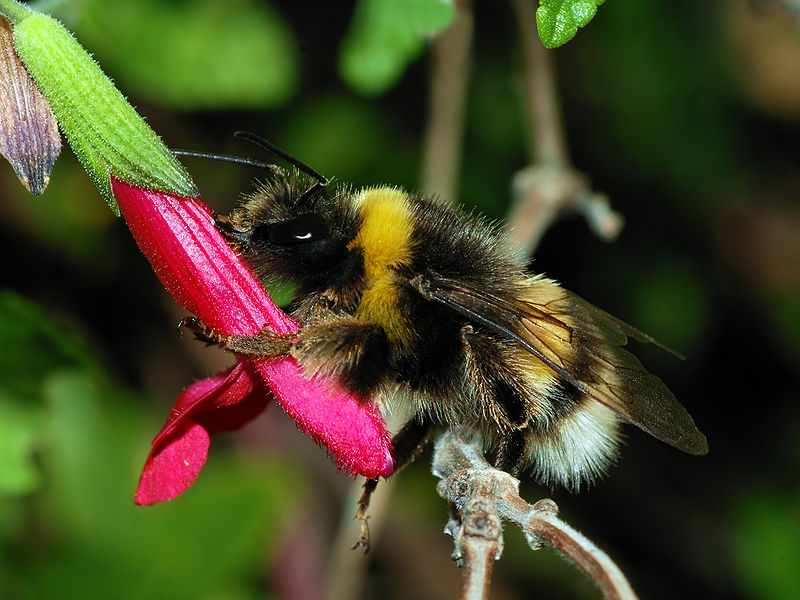Toxic Pesticides and the Flight of The Bumblebee: Are We Poisoning Our Future?


Photo source Wikipedia
Have you heard the buzz lately? Billions of bumblebees have been dying off, and, as a result, the entire global food chain may be in danger. Along with other insects, such as moths and hoverflies, bees pollinate around a third of the crops grown worldwide.
The humble bee is a much under-appreciated creature. In fact, life as we know it depends on it. Bees pollinate wild plants and agricultural crops, including some 90 per cent of the world’s commercial plants. Most fruits, vegetables and nuts, including okra, tomatoes, sunflowers, cucumbers, cashew, onion, cabbage, rapeseed, almonds, citrus fruits and cherries are all pollinated by bees, and coffee, soya beans and cotton are dependent on them to increase yields. Bees are at the forefront of a food chain that also sustains wild birds and animals.
As with other crucial pollinators, bees have been in serious decline around the world for the past few decades. Sydney Cameron, an entomologist at the University of Illinois, led a team on a three-year study of eight species of bumblebees in the US. The findings showed that the relative abundance of four of the sampled species had declined by up to 96 per cent and that their geographic ranges had contracted by 23 to 87 per cent, some within the past two decades. In the US, 50 to 90 per cent of commercial bee colonies are affected by ‘Colony Collapse Disorder’. The decline is however not restricted to the US. It’s a major global issue.
In the UK, for instance, three of the 25 British species of bumblebee are already extinct, and half of the remainder has shown serious declines, often up to 70 per cent, since around the 1970s. Bee populations have also been affected in the mainland Europe, China and India.
Reasons for the decline of bees may be many, including parasites, viral and bacterial infections, changes to habitat, pollution, poor nutrition stemming from intensive farming methods and even mobile phone frequencies. However, one of the causes points to the use of neonicotinoids, a nicotine-based pesticide that has been banned in France, Germany, Portugal, Greece, Italy and Slovenia.
In 2010, writer and activist Tom Philpott wrote that the US Environmental Protection Agency (EPA) allowed the widespread use of clothianidin, a neonicotinoid manufactured by the chemical and pharmaceutical company Bayer, despite warnings from the EPA’s own scientists.
Philpott’s evidence was based on a leaked internal EPA memo that revealed clothianidin has serious health impacts on bees, which may be directly related to their disappearance. The memo reported that studies show clothianidin is highly toxic and that information from standard tests and field studies, alongside incident reports involving similar insecticides, suggests the potential for long-term toxic risk to honeybees and other beneficial insects. In December, beekeepers and environmentalists in the US asked the EPA to remove its approval of the pesticide.
Nevertheless, the EPA has allowed the widespread use of the pesticide on corn, wheat and other staple food products. Meanwhile, Bayer raked in $262 million in 2009 from its sales of neonicotinoids to farmers.
Bayer continues to export or manufacture its pesticides across the world, including in India. In fact, imidacloprid, another neonicotinoid, is one of India’s highest selling pesticides.
Dr Parthiba Basu from the University of Calcutta argues that India is also experiencing a decline. His research team’s findings show that the yields of pollinator-independent crops have continued to increase, whereas pollinator-dependent crops have levelled off. In an attempt to identify an underlying cause for the pollinator decline, the team is comparing conventional agriculture with ecological farming. Basu states there is an obvious indication that within the ecological farming setting (where harmful pesticides are not used), there is pollinator abundance.
He added that if the team’s findings were extrapolated, this would offer a clear indication that India was facing a decline in natural pollinators, as ecological farming was only practiced on about 10-20 per cent of the country’s arable land. There are serious implications. Unlike those with access to a varied diet, Basu says there are certain vegetable crops that many people living near the poverty threshold rely on. If there is a pollination crisis, Basu suggests nutritional security could be affected.
In India, wild honey collection in the Kutch region of Gujarat in 2010 fell to 50 tonnes from the usual 300 tonnes in previous years because of the fall in the number of honey bees. The yield of certain native crops like date palms, lemon, papaya and kesar mangoes has also decreased. In Malda, West Bengal, mango honey was once good business, but farmers say bees are now avoiding mango trees.
There’s still a lot we don’t know about the massive bee die-offs. But one thing we do know is that bees are in trouble — by implication, we are too.
Given the revelations concerning the EPA in the US with regard to neonicotinoids, another thing we know is that we should no longer leave our food chain or ecology in the hands of the big chemical and pharmaceutical companies — nor should we rely on the regulating and policy bodies that are too often seen to be in their pockets.
Colin Todhunter : Originally from the northwest of England, Colin Todhunter has spent many years in India. He has written extensively for the Deccan Herald (the Bangalore-based broadsheet), New Indian Express and Morning Star (Britain). His articles have also appeared in various other newspapers, journals and books. His East by Northwest website is at: http://colintodhunter.blogspot.com

